How to run long distance with a dog
I’ve logged more than 10,000 miles running with more than 100 dogs of different sizes, ages, energy levels and breeds. While most dogs can handle running for shorter distances, what about running long distance with a dog?
The following are some of my own tips along with some advice from two others – a veterinarian and a fellow professional dog runner.
Tips for running long distance with a dog
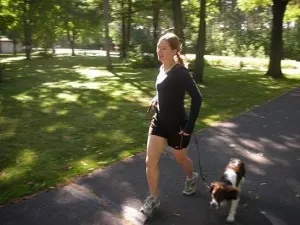
For the sake of this post and helping people get started with long-distance running, let’s assume anything over 6 miles is long distance.
Slowly increase the miles with your dog
If your goal is to run 6 miles with your dog, make sure she’s OK running 3 or 4 miles for a couple of weeks. Use common sense and start out conservatively.
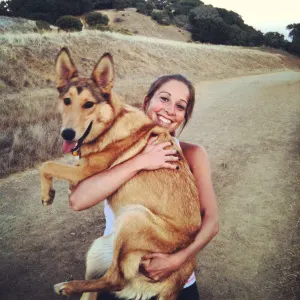
Running should be a positive experience for the dog, said dog runner Sarah Zwerin of Paws & Go in Marin County, Calif. She’s pictured holding her dog Obi.
“If the dog is looking exhausted, we’ll stop, sniff, greet others, and then get moving again for another half-mile or mile,” she said. “Eventually, their endurance will pick up, and you can go for longer stints without needing to stop.”
Once Zwerin is familiar with a dog, she said she offers up to 90-minute running sessions that cover up to 8.5 miles.
Pay attention to your dog’s behavior while running
Most dogs (although not all!) will tell you if they need to slow down by dragging behind. You should never force a dog to keep up, but sometimes it helps to use an encouraging voice – “Yeah, Ace! Come on, boy!”
Signs a dog needs a break could include:
- Heavy panting
- Dragging behind
- A long tongue
- More drool or “foam” around the mouth than usual
- The weather is hotter or more humid than usual
- Limping
- The dog tries to stop or lie down, especially in shady areas
- The dog shows more interest than usual in stopping to sniff or pee on things
Realize some dogs don’t have an ‘off switch’ while running
My mutt Ace will literally chase a tennis ball until he hurts himself or collapses. I have to physically remove the ball or put him on a leash to stop him.
Certain dogs are the same way with running as Ace is with chasing a ball. They will run until they reach exhaustion. They seem to lack the ability to stop until their bodies physically can’t go on. Until you know your dog’s limits, keep the distances a little slower and shorter than you think he can handle.
Check for sore or worn paw pads during runs
When a dog runs on pavement or concrete every day, he will naturally develop tougher, calloused paws. A dog that is not used to running on harder surfaces may have softer paws that could get sore or “scuffed.”
“Puppies have very sensitive paws as they have not become calloused yet,” said Dr. Thomas Watson, owner of Carolinas Veterinary Medical Hospital in Charlotte, N.C. “It is very easy to rub their paws raw or burn their feet on hot concrete.”
If your dog wears through his pads while running, he may not show any signs of pain until after the run. That’s why it’s important to stop and check the bottom of your dog’s paws every 10 minutes or so when you first increase his miles.
Watson recommends dog owners take their dogs running on smooth, even trails or roads as much as possible because gravel and pebbles can hurt a dog’s feet.
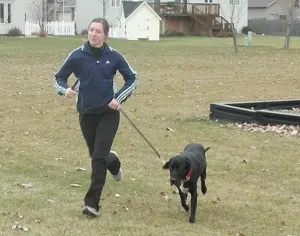
Watch for stiffness in your dog after a run
If your dog appears stiff and sore after every single run, then you should decrease his miles a bit or give him a day or two of rest between each run. You should talk to your dog’s vet if you have any concerns about injuries or joint issues with your dog.
Speed is a factor when running with your dog
Dogs are better equipped to be sprinters than marathoners, according to Watson. “But with proper training and slower paces they are able to become distance runners.”
He said running is an excellent form of exercise for the right breeds, and some are better runners than others.
For example, Watson’s 12-year-old dalmatian mix ran 12 miles this spring when the weather was cooler. “He has been running all of his life and is used to the longer distances,” Watson said. “Just like people who are runners, they need to build up to the longer distances.”
He recommends starting out with a 10-minute-per-mile pace or slower and gradually building up speed and distance.
Through my own dog running business, I’ve noticed the dogs tend to walk fast or “trot” beside me as long as I maintain a slow pace. If the dog has to actually run (looks like a gallop), he won’t be able to maintain the pace for long.
Zwerin pointed out how a dog may do quite a bit of pulling, marking or sniffing during the first mile or so.
After that “their energy starts to become focused on running – rather than the novelty of being outside – and a rhythm is more easily achieved.”
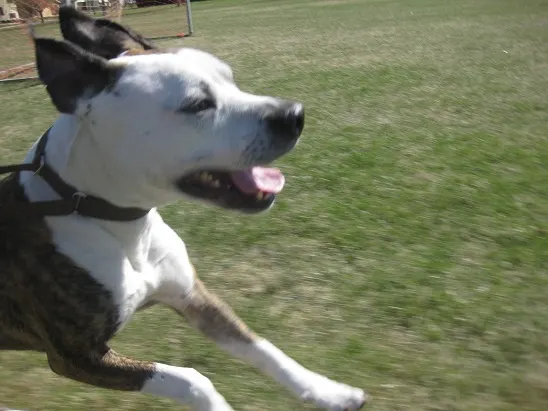
Provide an opportunity for water while running
No one likes to run while holding a leash and a water bottle, but sometimes it’s unavoidable.
On hot days, Zwerin said she tries to take a route that has an area for the dogs to get water, too.
“Carrying a water bottle is tricky,” she said. “It’s bulky, heavy, awkward to hold, and with up to three dogs with me sometimes, it runs out quickly.”
Of course, on really hot days, there’s no getting around it and her water bottle of choice for the dogs is called the Gulpy.
Watson said many dogs won’t drink during a run even if they need it.
“A squirt bottle works well to open their mouth and force a small amount,” he said.
Can small dogs run long distance?
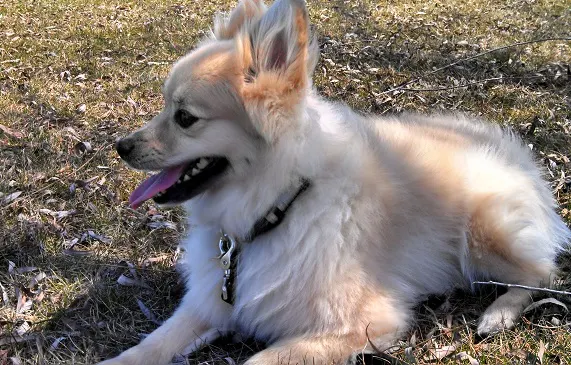
Some can! It’s not so much about the size of the dog. It’s about your dog’s energy level, body build and endurance.
“They’re equally eager to burn their energy off, too,” said Zwerin, who regularly runs with two “sister” dogs under 15 pounds.
“I’ve pushed them to do 5-and-a-half miles a handful of times,” she said. “And though they finished, they were wiped by the end.”
Can large or giant dog breeds go running?
It depends on the individual dog. When I’m running with larger breeds, I try to let them set the pace. They tend to run a little slower than smaller dogs, and we might cover less distance.
Watson said giant breeds may not be ideal runners, but they can do OK if the distance is kept under 2 miles. He also mentioned giant breeds should wait until they are at least a year old before they start running. More details on that below.
When is a puppy old enough to go running?
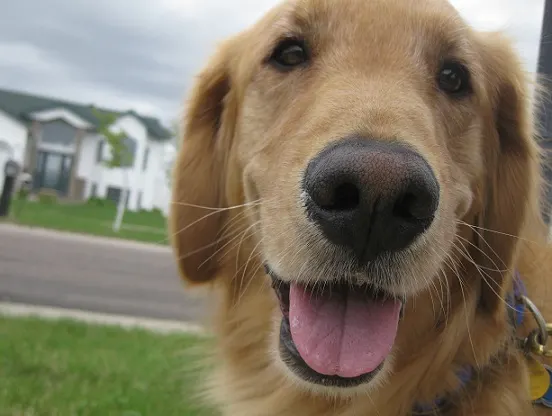
I hesitate to tell people not to take their young dogs running. Exercise is important for a dog’s health, and it also helps with training and socializing.
Still, I often hear that dogs shouldn’t go running until they are 12 to 18 months old, so I asked Watson for his opinion.
By the time most dogs are 6 months old, their musculoskeletal systems have grown to about 75 to 80 percent of their adult size, he said.
He gave some general recommendations on when it’s safe to start running with a dog based on the dog’s predicted size at maturity:
- For dogs expected to weigh less than 60 pounds at maturity: Start running when the pup is between 6 and 8 months old
- For dogs expected to weigh between 60 and 100 pounds: Start running when the pup is between 8 and 12 months old
- For dogs expected to weigh more than 100 pounds: Start running when the dog is between 12 and 18 months old (giant breeds tend to have more problems with juvenile bone diseases during their growth phase, so extra care should be taken during this time)
Of course, it’s always best to start out slowly and with short distances, regardless of the pup’s size.
Zwerin said she started running with her dog Obi once he was about 9 months old. She increased the distance to 4 miles or more once he was about a year old.
“We were at the point where when we’d go for off-leash hikes or walks, he’d run ahead of us most of the time,” she said. “I took that as a green light for running with him, and in turn, making sure he kept up with me.”
For more details: When can a puppy start running?
What advice do the rest of you have about running long distance with a dog?
Related posts:
Ultra marathon training with your dog
Training sled dogs for Yukon Quest

Anabel
Thursday 1st of March 2018
Hi! I loved your article because a week ago a vet terrified me about running with my dog. They told me that I was doing irreperable damage because she was too young (she didn't even saw my dog). My dog is a Rhodesian Ridgeback and she is gonna be 1 year old in 2 weeks. I waited until she was 8 months old to start increasing distace/repetition and trained her as I trained myself at the beggining (increasing 0.5 miles/2 weeks). We were running 5 miles by now. Truth is, she is so big, that she only walks fast by my side even if I run at a 9 min/mile peace. After each milage increase I checked her paws, legs and made sure after resting for a while she recovered all of her energy. It took her about 8 hours to go to the front door trying to get out again. Did I did it wrong?
Lindsay Stordahl
Thursday 1st of March 2018
I'm sure your dog is fine.
Teebird415
Tuesday 23rd of August 2016
@toofast ! Being in tune to your dogs needs led you to start biking with them. That judgmental lady didn't know that part! But Maybe she'd seen people running or cycling their dogs previously where the dog was struggling and the pet parent was oblivious to it. It caught her nerve. It definitely was NOT the case with you. I'm glad I realized my Smittie wasn't going to be a runner. That might have contributed to her very long life. (See my above EXTREMELY LONG POST LOL) NTL keep up the good work!
Teebird415
Tuesday 23rd of August 2016
We rescued our very first Staffy, Lulu, after another rescue, our Smittie, a Boxer mix passed after 14 years. Smittie would run with me a few times a week and since we live near the coast, could tolerate 3-5 miles at a 8-10 minute mile pace. Then one day, at around 5 years of age, she stopped in the middle of a run. I literally had to walk her home. It wasn't too warm, I didn't think at the time, but I watched her for symptoms and she recovered quickly after we got home. I decided to try again at another cooler part of another day And the same thing happened. At that time I realized that running is not good for some dogs with an underbite and barrel chest. I realized that it was hard for her to pant and oxygenate due to her anatomy. Try to jut your chin out past your upper palate and breathe through your mouth! Then run and do it! I thought at this point I was on to something since many boxers pass from boxer cardiomyopathy. Their bodies are simply too athletic for their facial structure so the lack of oxygenation during intense exercise is very possibly hard on their heart. Long story shorter, Smittie enjoyed zoomies and long walks but never ran distance again. She lived 14 years and was very healthy to the end. Fast forward to Lulu. Girl can't get enough exercise! Barely warms up at 3 miles into a run. Her pace is CRAZY fast. She's young and needs the exercise! SO We started training her to cycle with us in order to drain her energy. First, Must have a easy riding bike like a beach cruiser. I hold the leash lightly in my left hand and I do not allow her to pull. I talk to her the whole time Giving command and praising her. Leave its are in order until she gets a bit more tired. Also, Slow Down and Turning are some commands. She loves it SO much and it really drains her energy. By about 1.5 - 2 miles in, she finally relaxes and runs at an easy pace. We take frequent water breaks (riders squirt bottle). She is so calm the rest of the day! I treat her to a heeling /loose leash walk around early evening. She is really becoming balanced through this form of energy release. Believe me, it was scary the first few times I had her out there on a bike! It was Unbelievable how a short 50 lb dog could pull me @ 138lbs or hubs at 190lbs!! Maintaining the same commands while running or walking is the way we figured it works best. Pulling creates too much excitement for her. Also, we go down a shady path in a cooler time of day. We're at the point that we can pass other dogs and she stays in her heel! That's an accomplishment since she's super dog social. She's super relaxed for the rest of the day after this. Anyone else out there discovered this as a feasible form of exercise for their pup?
Jess
Friday 11th of September 2015
a great article. I compete in endurance horse riding and my 2 dogs are my number 1 training buddies. Whether it's beach or mountain training they always get excited about it. But having struggled to find anyone else who works their dogs hard I have always wondered if the long distances (20-40km at a time at a horses fast trot or canter) would do any long term damage and people often seemed shocked that I ask them to run that far. My collie x retriever copes the best and is still bouncing around at the end, while the lab x staff has taken some getting used to which due to the breeding I knew she would need to more time to adjust to the distance and speed. Especially since I'm on horse back and their legs are much shorter than the horses! it's a fairly decent pace to keep up with. With breaks for swims and drinks at water crossings and such as the horse needs them too. But I feel better knowing that I'm not alone in this!
Joe Wallendorff
Monday 24th of August 2015
I have been running with my Lab who is now 22 months old and I learned the other day what not to do. I made several mistakes: I knew he could go up to 10 miles with no trouble at all but not at race pace. During a 7.5 trail run his legs got real rubbery and I had to force him down before he twisted something. We were near a water stop and he rested about 15 minutes while I did the short out and back. Later he went down again this time without water and I had to stop for 20 minutes and fan him. We made it another water stop then he was fine the rest of the race. Each time he was wanting to start running again and would look back at me to come on. My mistakes were that I wanted to race and so did he. (he's not had any speed work). The race was at 5:30 PM and very hot, we should have just had fun. He's now my training partner not racing partner on anything over a 5K.
Lindsay Stordahl
Wednesday 26th of August 2015
That makes sense, especially since you must run at a good pace during races. I find that most dogs are not able to maintain a quick speed. I am not a very fast runner. I typically run at about a 10-minute per mile pace and the dogs are usually running behind me after the first mile or so.
There are exceptions, though! I have not met a Lab that can maintain a fast pace, but I've met some pointers and a Doberman that I was never able to tire out.